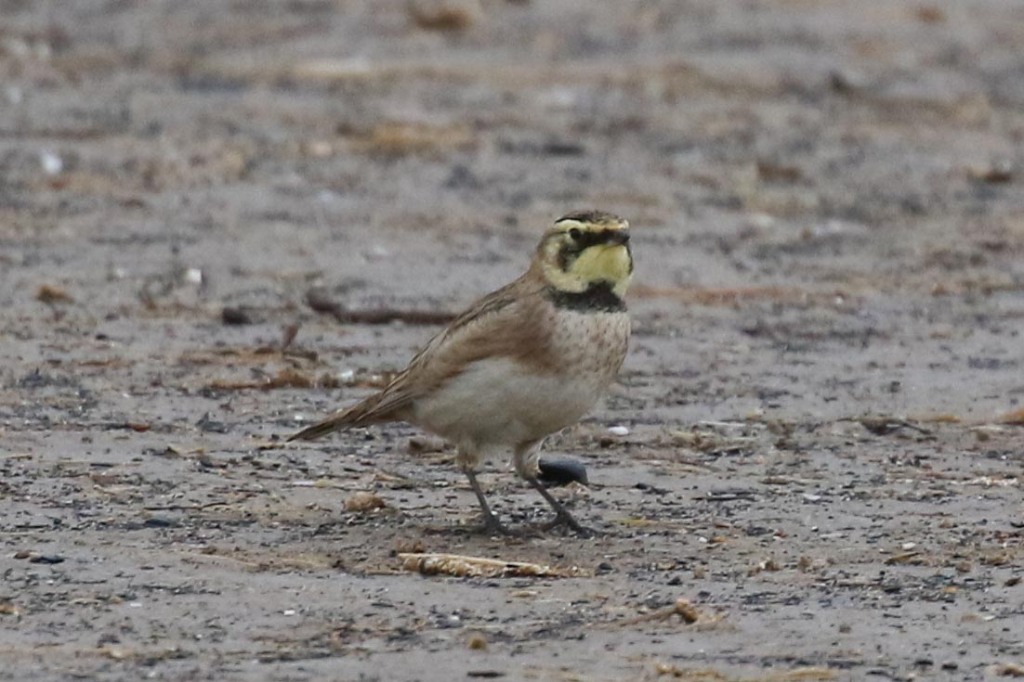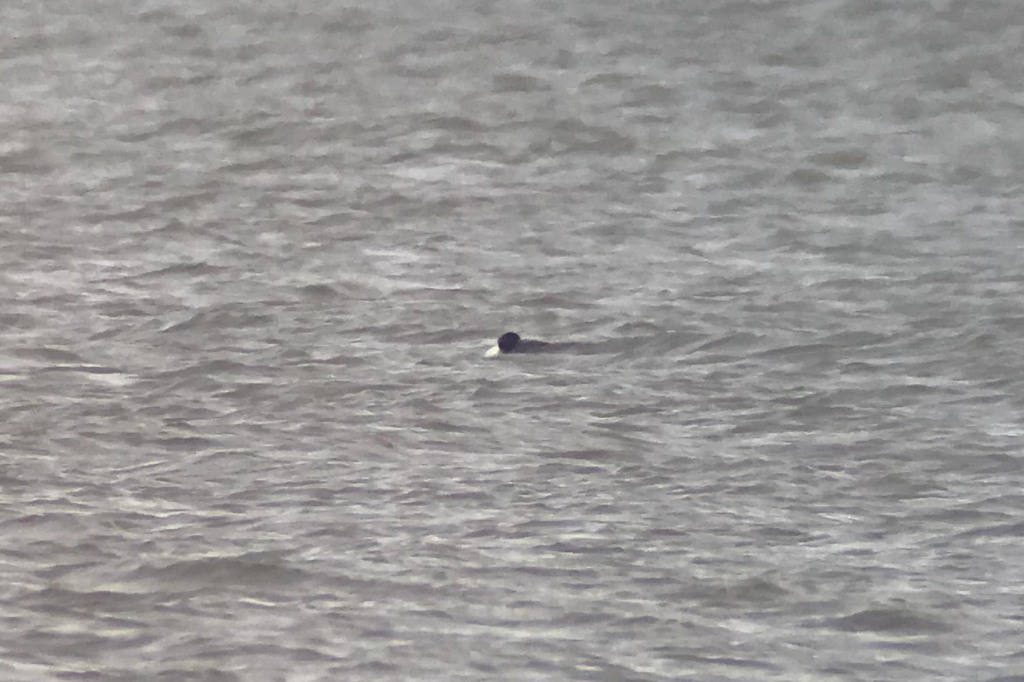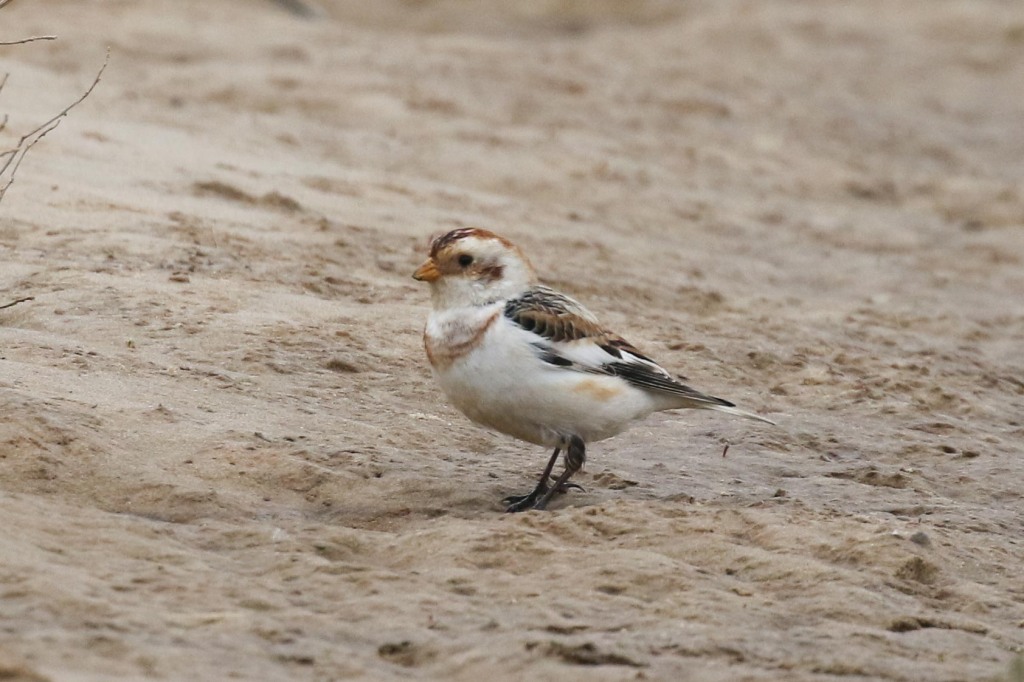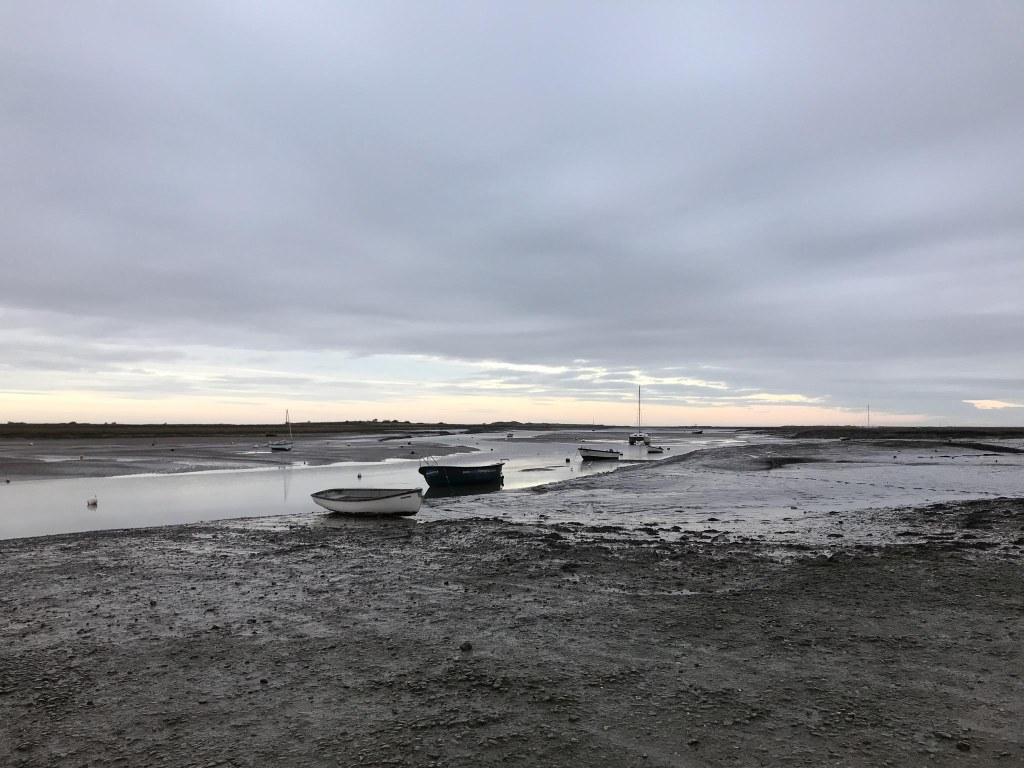Day 1 of a three day Private Winter Tour today. It was rather grey and cloudy, mostly dry although there was a little bit of misty drizzle on and off around the middle of the day. It was rather mild though, and the wind wasn’t as blustery as it has often been in recent days. We spent the day along the North Norfolk coast.
It was drizzling on our way down to Holkham, but thankfully had stopped by the time we arrived. Getting out of the minibus, we went over to scan the grazing marshes from the edge of Lady Anne’s Drive first. There were lots of Wigeon out on the grass, and a few Teal and Shoveler and a pair of Gadwall around the pools. A pair of Pintail were upending out in the middle, the drake showing off its long pin-shaped tail. Six Barnacle Geese were feeding at back, alongside several Pink-footed Geese too.

A Great White Egret was lurking in the ditch at the back, and as it finally walked out into view, at first all we could see was its head and its long yellow dagger of a bill. There was a nice selection of waders too – several Common Snipe tucked in the grass, Redshank and Curlew, a pair of Oystercatchers and a Black-tailed Godwit flew over.
A single Fieldfare was out on the grass too and a couple of Marsh Harriers were hanging in the air at the back. Further up, we found a pair of Grey Partridge on the top of the bank, above the ditch, and a single Red-legged Partridge was feeding with them. An interesting comparison of the two, side-by-side.
As walked through the pines, we came across a tit flock feeding in the trees – Long-tailed Tits and a few Blue Tits, a Coal Tit singing. Several Goldcrests were flitting around up in one of the holm oaks and a Treecreeper appeared on the trunk briefly. It disappeared out the back before everyone could see it, but we then found it again working its way up the trunk of a pine the other side of the path.
We turned west and walked out through the dunes. A large flock of Shelduck was out on the saltmarsh at back. Then we noticed several smaller birds moving in the vegetation closer to us – lots of Meadow Pipits, and one or two Rock Pipits with them, the latter darker, swarthy, dirtier and more heavily marked below with blotchier spots. There was a small flock of Linnets, and one or two Skylark in there too.
As we carried on out onto the beach, a couple of other birders strode off ahead of us out across the sand. We followed the edge of the dunes more closely and suddenly we realised there were the four Shorelarks right beside us. Very easy to walk past! We had a great view of them. Then a Meadow Pipit alarm called from the dunes behind, and the Shorelarks flew and landed further out on the beach.

After a couple of minutes, the Shorelarks flew back in and landed right beside us again. Now we had a bit more time to get them in the scopes and get a closer look.
When the Shorelarks eventually flew a bit further back along the edge of the dunes, we walked out to have a look at the sea. There were a few Oystercatchers on the beach and a small group of Sanderling running up and down along the shore.
Scanning out to sea, we picked up a lone Great Northern Diver. We could see its large bill and dark half collar, until it tucked its head in and went to sleep, bobbing up and down on the waves. There were several Great Crested Grebes too, and some Common Scoter, three closer in and a small raft on the sea further back behind them. Three Red-breasted Mergansers flew past and a rather distant Red-throated Diver flew east, before one of the group picked up three more on the water.

We hadn’t seen any Snow Buntings out this way, so we decided to try the other side. As we walked back along the beach towards the Gap, a Ringed Plover flew in and landed on the sand in front of us. A Skylark fluttered up singing over the dunes as we passed, and we came across more Meadow Pipits and a Rock Pipit on the saltmarsh in front of the boardwalk.
We turned east now, and walked out along the edge of the saltmarsh to the cordon. As we arrived at the corner, we could see a flock of Sanderling feeding just beyond the fence a little further down. They flew up and out to the middle, and as they did so a flurry of Snow Buntings came up too. There looked to be around eighty of them and thankfully they all dropped down again.
They seemed to be working their way across towards the path out to the dunes, so we walked up along the side of the cordon. As we stood and watched the Snow Buntings feeding, they came progressively closer and closer until they got to the path where we had positioned ourselves. Then they continued out onto the path right in front of us – stunning!

The Snow Buntings crossed over to the other side of the path and then took off. They swirled round and flew over and landed on the track back towards the Gap. We had enjoyed great views so decided to walk back that way – but the Snow Buntings were quickly flushed by walkers and flew up over the pines.
We made our way back to The Lookout to use the facilities. A huge flock of Golden Plover whirled round in the air behind, before dropping back down over towards Wells. As we walked back to the minibus, a pair of Mistle Thrushes was now on the grass the other side of the Drive. We had a quick look for the White-fronted Geese from the road, but there was no sign in any of their favoured spots, so we turned round and drove back east.
We had a request to see a Little Owl, so we diverted inland and quickly found one on the roof of some barns. We stopped to look, and as we got the scopes on it we realised there was a second Little Owl tucked in under the roof just behind it.

The Red-breasted Goose had been on Blakeney Freshes this morning, so we called in on our way past. There had been no update for a while though and there were no cars in the car park when we arrived, always a worrying sign. We hadn’t gone too far along the seawall when we bumped into another birder coming back who said all the geese had flown but he didn’t know which way.
It was just about time for lunch, so we decided to have a break first and the try to find the Red-breasted Goose afterwards. As we walked back to the minibus, a Cetti’s Warbler shouted from the reeds and a Marsh Harrier drifted over. As we set off towards Cley, we saw a small flock of Brent Geese heading inland up the Glaven Valley – we hoped the Red-breasted Goose had not gone with them!
The Brent Geese have been feeding at Cley too sometimes, so we had a quick drive round to check the grazing marshes where the Red-breasted Goose has been seen. There was no sign in the Eye Field nor down by Babcock Hide, where we had seen it yesterday. So we turned back to the Visitor Centre for lunch.
Just as we settled down at the picnic tables, the cloud thickened and a bit of light drizzle started falling – perfect timing! Thankfully it was not too bad and patchy – not enough to ruin our lunch. Several Avocet were out on Pat’s Pool and a Marsh Harrier drifted over, disturbing everything.
After lunch, there were still no further reports of the Red-breasted Goose. Hoping it would still be at Blakeney, we drove round to the village and walked up onto Friary Hills to scan the Freshes. We could see a flock of Brent Geese out in the middle below us, but they were mostly hidden by some reeds. A few more Brents were visible way off in the NE corner, with some Pinkfeet, but most of that flock were hidden from view too so it was impossible to say how many were with them. And the Red-breasted Goose could even have headed off inland earlier.
We were still trying to work out what the best approach would be to find the Red-breasted Goose when we got a glimpse of it behind the reeds in the flock of Brents out in the middle. At least we now knew where it was! We then spent some time getting various glimpses – it would appear behind the sparser reeds where we could just make it out, then walk out of view again. We picked out a Pale-bellied Brent in the flock too.
There was a nice bench here to rest our legs and there were a few other birds out here to see too – several Marsh Harriers including a smart pale male, a Little Egret or two. Four Greenfinches landed in a young oak tree in front of us.
We noticed thousands of Pink-footed Geese way off in the distance off Cley beach, which looked to be heading out to sea in a series of long lines. Some then came past us in several skeins a little later, calling – a wonderful sight and sound, so typical of Norfolk in winter. It was only the following day that we read that the number of geese at Cley had dropped dramatically and Pink-footed Geese were seen migrating north over Spurn – the birds we had seen were already heading north, leaving us. The spring exodus of the geese was starting!
Turning our attention back to the Brents, a small group flew up from behind the reeds and circled round before landing out in the open further back. Unfortunately the Red-breasted Goose was not with them. Then the rest of the geese went up too and this we could see the Red-breasted Goose as it took off. The flock circled a couple of times, then landed again, this time in front of the reeds where we could see them. Finally we got a proper view of the Red-breasted Goose!

It had taken longer than planned to see the Red-breasted Goose and the afternoon was already getting on now. As we made our way back to the minibus, some of the group got distracted by the Blakeney wildfowl collection where one of the resident captive Red-breasted Geese was now showing (we had looked on the way out but they were out of view). That one doesn’t count!
We set off west. We made another quick stop at Holkham, where we could now see the flock of White-fronted Geese distantly on the old fort at the back. We had been hoping to get to Titchwell this afternoon, but as we drove on west the light was already starting to go. There were a few waders we hadn’t seen and wouldn’t catch up with elsewhere so a quick change of plan and we diverted down to the harbour at Brancaster Staithe.
As expected, there was a nice selection of waders here – Turnstones, Grey Plovers, Bar-tailed Godwits and Oystercatchers. There were very good numbers of Ringed Plover here today – we counted over 40 out on the sandbank in the middle, and five more on the bank opposite us. There were several Dunlin too. Lots of Teal and Redshank flew in and landed down on the water higher up the channel. A steady stream of Pied Wagtails dropped in down onto a catamaran beached out in the middle of the harbour, presumably to roost. We could see lots of them perched on the decks in the scope and rails.

It was lovely light now, looking out across the harbour. We had another busy couple of days ahead, so we decided to to call it a day and head for home.
















